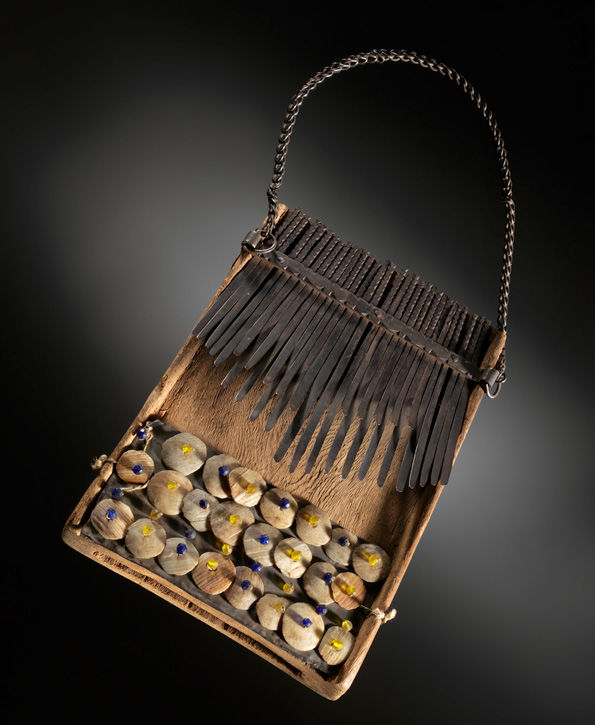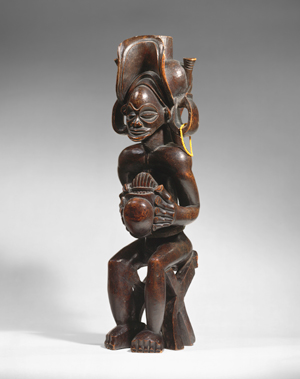Hall plays a rather unusual combination of two instruments, one that he calls the "kalimbatar." This hybrid instrument merges an acoustic guitar with a specially designed version of the West African kalimba. Kalimba is one name for a type of instrument known as a lamellaphone, consisting of thin metal or split cane tongues mounted on a resonating board or box. Depressing the free ends of the tongues with the thumb produces a gentle ringing sound, which is sometimes augmented by jingling objects. An example of a similar instrument, possibly by the Barwe people—members of the Shona community in the Zambesi province of Mozambique—can be found in the Museum's collection.

Nyonganyonga. Zambesi province, Mozambique, ca. 1900. Wood, shell, metal, beads.
The Metropolitan Museum of Art, New York, The Crosby Brown Collection of Musical Instruments, 1889 (09.163.6)
In conjunction with the exhibition Early American Guitars: The Instruments of C. F. Martin, on view through December 7, the Department of Musical Instruments is presenting a series of monthly concerts on Friday evenings in the Museum's Charles Engelhard Court. The next concert in this series will be held on May 16, featuring the guitarist, composer, and instrument designer Trevor Gordon Hall.
Trevor Gordon Hall performing an original composition on the kalimbatar, 2011
This example has thirty-one metal keys and disks made of snail shells that are pinned to the body and rattle when played. Tuning is accomplished by sliding the tongues in or out to alter their vibrating length and pitch.

Lamellaphones are found across sub-Saharan Africa and were brought to Latin America by enslaved Africans. They are known by many names that may be shared with xylophones, but, overlooking differences in construction, are generally identified by two regional terms: mbira or sanza. Depending upon the context and regional tradition, lamellaphones may be used to accompany narratives and children's songs, or to summon spirits and induce trance and spirit possession, thus bridging this world with that of watchful ancestors.
The use of thumbs to play the instrument is the reason why the lamellaphone is often known to Westerners as the "thumb piano."
Left: Seated Chief Playing Thumb Piano (Mwanangana). Angola, before 1869. Wood (Uapaca), cloth, fiber, beads. The Metropolitan Museum of Art, New York, Rogers Fund, 1988 (1988.157)
The Metropolitan Museum of Art, New York, The Crosby Brown Collection of Musical Instruments, 1889 (09.163.6)
In conjunction with the exhibition Early American Guitars: The Instruments of C. F. Martin, on view through December 7, the Department of Musical Instruments is presenting a series of monthly concerts on Friday evenings in the Museum's Charles Engelhard Court. The next concert in this series will be held on May 16, featuring the guitarist, composer, and instrument designer Trevor Gordon Hall.
Trevor Gordon Hall performing an original composition on the kalimbatar, 2011
This example has thirty-one metal keys and disks made of snail shells that are pinned to the body and rattle when played. Tuning is accomplished by sliding the tongues in or out to alter their vibrating length and pitch.

Lamellaphones are found across sub-Saharan Africa and were brought to Latin America by enslaved Africans. They are known by many names that may be shared with xylophones, but, overlooking differences in construction, are generally identified by two regional terms: mbira or sanza. Depending upon the context and regional tradition, lamellaphones may be used to accompany narratives and children's songs, or to summon spirits and induce trance and spirit possession, thus bridging this world with that of watchful ancestors.
The use of thumbs to play the instrument is the reason why the lamellaphone is often known to Westerners as the "thumb piano."
Left: Seated Chief Playing Thumb Piano (Mwanangana). Angola, before 1869. Wood (Uapaca), cloth, fiber, beads. The Metropolitan Museum of Art, New York, Rogers Fund, 1988 (1988.157)
Related Link
Gallery Concert: Trevor Gordon Hall, Guitar
Department(s): Musical Instruments
Tag(s): gallery concert, guitar, kalimba, kalimbatar
fonte>http://www.metmuseum.org/about-the-museum/museum-departments/curatorial-departments/musical-instruments/of-note/2014/kalimba?utm_source=Twitter&utm_medium=tweet&utm_content=20140512&utm_campaign=ofnote @edisonmariotti - #edisonmariotti
Kalimba, or the "Thumb Piano"
Posted: Monday, May 12, 2014


Nenhum comentário:
Postar um comentário